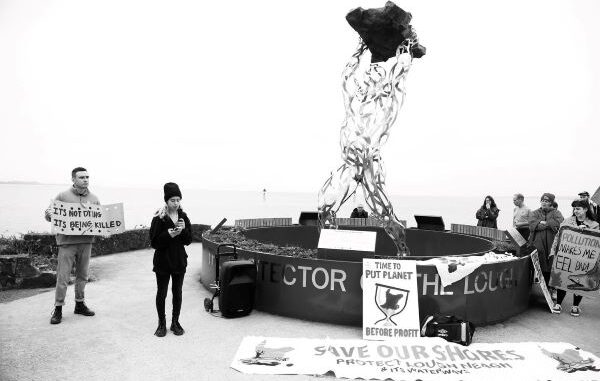
Lough Neagh is a freshwater lake in Northern Ireland and is the largest lake on the island of Ireland and in the United Kingdom. According to Northern Ireland Water, it supplies 40.7% of Northern Ireland’s drinking water. Lough Neagh is also home to the largest wild eel fishery in Europe. However over the last months Lough Neagh has been plagued by pollution and an environmental crisis, which has also badly hit the eel fishery.
Joanne Elder looks at the causes of the environmental crisis, the lack of response of the political establishment, and the Save Lough Neagh campaign.
socialistworld.net
Save Lough Neagh is a coalition of environmental activists fighting to defend our lough from pollution and extractive exploitation. They held a “Rally Against Stormont Inaction” at the shores of Lough Neagh in Antrim town on Sunday 1st September 2024, where they and members of the public met to protest the continued inaction on the Lough Neagh ecosystem. The campaigners are demanding more urgency is needed to tackle the environmental crisis crippling the shores of Lough Neagh and want to ensure they continue to hold structures in power accountable. A Stormont [the seat of lower power sharing government] action plan aimed at addressing the environmental crisis that is “killing” Lough Neagh has drawn criticism from the Save Lough Neagh Campaign.
Last summer, toxic blue-green algal blooms covered large sections of the lough, impacting surrounding beaches and other waterways. For dogs and other animals, these blooms can be fatal. Despite the algae retreating for the winter, the algae returned this summer. The immediacy of the loss of biodiversity, the loss of fish life, aquatic life, bird life and insect life around Lough Neagh has been catastrophic. Major factors cited include nitrogen and phosphorous from agricultural fertiliser running off fields, the spread of the invasive zebra mussel species and climate change.
Lough Neagh is owned by The Earl of Shaftsbury. The Shaftsbury estate has held ownership of the bed and soil of Lough Neagh since the 19th century, after the Chichester family took control in the 17th century. The earl is paid a royalty for every tonne of sand extracted from two zones licensed for extraction in the north-west of the lough. A maximum of 1.5m tonnes may be extracted per year. There has been calls for the lough to be taken into public ownership as part of addressing the problems that have led to unprecedented algal blooms. The Lough Neagh Partnership (LNP) whose claim is to represent many bodies has representatives of the sand dredging corporations and the Earl of Shaftesbury himself. Save Lough Neagh campaigners question the transparency and accountability of the LNP, accusing it of failing to confront ethics of extracting and facilitating corporate greed.
Dr. Neil Reid, a biologist at Queens University Belfast’s Institute of Global Food Security, found in a recent study that most of the foul-smelling algal blooms along the lough’s shores are caused by bacteria associated with human and livestock faeces, which releases a “suite of toxins”, known as cyanotoxins. These exposures to cyanotoxins at Lough Neagh exceed WHO guidelines. Whilst Northern Ireland Water, the regulatory body, “test for the most common” cyanotoxins Dr. Reid is concerned some are carcinogens and that their health impacts would be cumulative rather than immediate.
Over 40% of the drinking water in the region comes from Lough Neagh. Anabaenopeptins, a “whole other class of toxins,” have been discovered in the lough, and they interact with cyanotoxins to “produce even greater toxicity than any one by itself.” It was recently confirmed by NI Water that it does not test for anabaenopeptins before or after the water has been treated. According to NI Water, “there is no explicit testing, but the multi-filtration system is effective against cyanotoxins and is likely effective against other compounds.”
Save Lough Neagh campaigners reiterate that grassroots campaigning in local communities is the only way to achieve real change and through building a power movement Lough Neagh can be protected from the polluters, the profiteers and the ‘extractavists’. A further rally was held at Stormont parliament buildings on Sunday 8th September 2024 at 2pm and the campaign needs to widen and develop.
